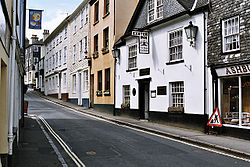Ashburton
| Ashburton | |
| Devon | |
|---|---|
 West Street in Ashburton | |
| Location | |
| Grid reference: | SX756698 |
| Location: | 50°31’1"N, 3°45’4"W |
| Data | |
| Population: | 3,909 (2001) |
| Post town: | Newton Abbot |
| Postcode: | TQ13 |
| Dialling code: | 01364 |
| Local Government | |
| Council: | Teignbridge |
Ashburton is a small town on the southeastern edge of Dartmoor in Devon. It stands beside the A38, the major route south around the moor.
Ashburton was formerly important as a stannary town and a centre for the administration of tin-mining. It remains the largest town actually within the Dartmoor National Park, with a population of around 3,500.
History
The name is recorded in the Domesday Book of 1086 as Essebretone. Ashburton was then the main town of the Parish of Ashburton, in Teignbridge Hundred.
In 1305 King Edward I issued the Stannary Charter which established three towns on the edges of Dartmoor as Devon’s stannary towns: Tavistock, Ashburton and Chagford. These towns had a monopoly on the trade of all tin mined in Devon and a right to representation in the Stannary Parliament. Thereafter through the Middle Ages Ashburton prospered through the trade.
During the Civil War, Ashburton was a temporary refuge for Royalist troops fleeing after their defeat by General Fairfax at nearby Bovey Tracey.
The town was the terminus of the Buckfastleigh, Totnes and South Devon Railway that opened on 1 May 1872. Ashburton railway station closed to passengers in November 1958 although goods traffic on the line continued until 7 September 1962.
Carnival
Ashburton Carnival is one of the oldest, possibly the oldest, surviving in Devon. Written records date it back to 1891, but it is believed to have been started in the mid-1880s to raise funds for a new hospital.
Sites of interest
The parish church of St Andrew is a fine building of the 15th century with a tall tower and two aisle. The fifteenth century church tower features sculptures by Herbert Read, who also carved the oak reredos. One window has stained glass by C. E. Kempe. The porch is partly Norman.[1]
The historic St Lawrence Chapel is a unique and important Grade ll* Listed Building situated in St Lawrence Lane in the heart of Ashburton. Originally a Chantry Chapel (suppressed at the Reformation) and subsequently for over 600 years a Grammar School, St Lawrence Chapel is now an important Heritage, Cultural and Community Centre, managed by the Guild of St Lawrence.
Saint Gudula Well and Cross in Old Totnes Road is probably named after St Gulval, whose name appears also at Gulval in Cornwall.
Miscellany
Ashburton Pop
Ashburton used to be famous for a beverage known as Ashburton Pop, possibly a type of champagne, the recipe of which was lost with the brewer in 1765.[2]
Civic tradition
The town is one of a few to still annually appoint a Portreeve or 'port warden'. Others are Laugharne, Beccles, Callington (where the name is given to the council chairman), Cheevel, and Yeovil.
Ashburton was the first place to elect a candidate of the Official Monster Raving Loony Party to public office. The candidate was “Howling Laud Hope” (Alan Hope), a local publican, who was elected unopposed to Ashburton Town Council in 1989. He subsequently became Deputy Mayor and later Mayor of Ashburton.
Outside links
| ("Wikimedia Commons" has material about Ashburton) |
- Town website
- Devon Local Studies - Ashburton community page
- Ashburton in the Domesday Book
- official Chapel website
References
- ↑ Pevsner, N. (1952) South Devon, Penguin Books; pp. 38-39
- ↑ ["The Noted John Cooke of Exeter"], The Every-day Book and Table Book; or, Everlasting Calendar of Popular Amusements, Sports, Pastimes, Ceremonies, Manners, Customs, and Events, Each of the Three Hundred and Sixty-Five Days, in Past and Present Times; Forming a Complete History of the Year, Months, and Seasons, and a Perpetual Key to the Almanac, Including Accounts of the Weather, Rules for Health and Conduct, Remarkable and Important Anecdotes, Facts, and Notices, in Chronology, Antiquities, Topography, Biography, Natural History, Art, Science, and General Literature; Derived from the Most Authentic Sources, and Valuable Original Communication, with Poetical Elucidations, for Daily Use and Diversion. Vol III., ed. William Hone, (London: 1838) p 356]
